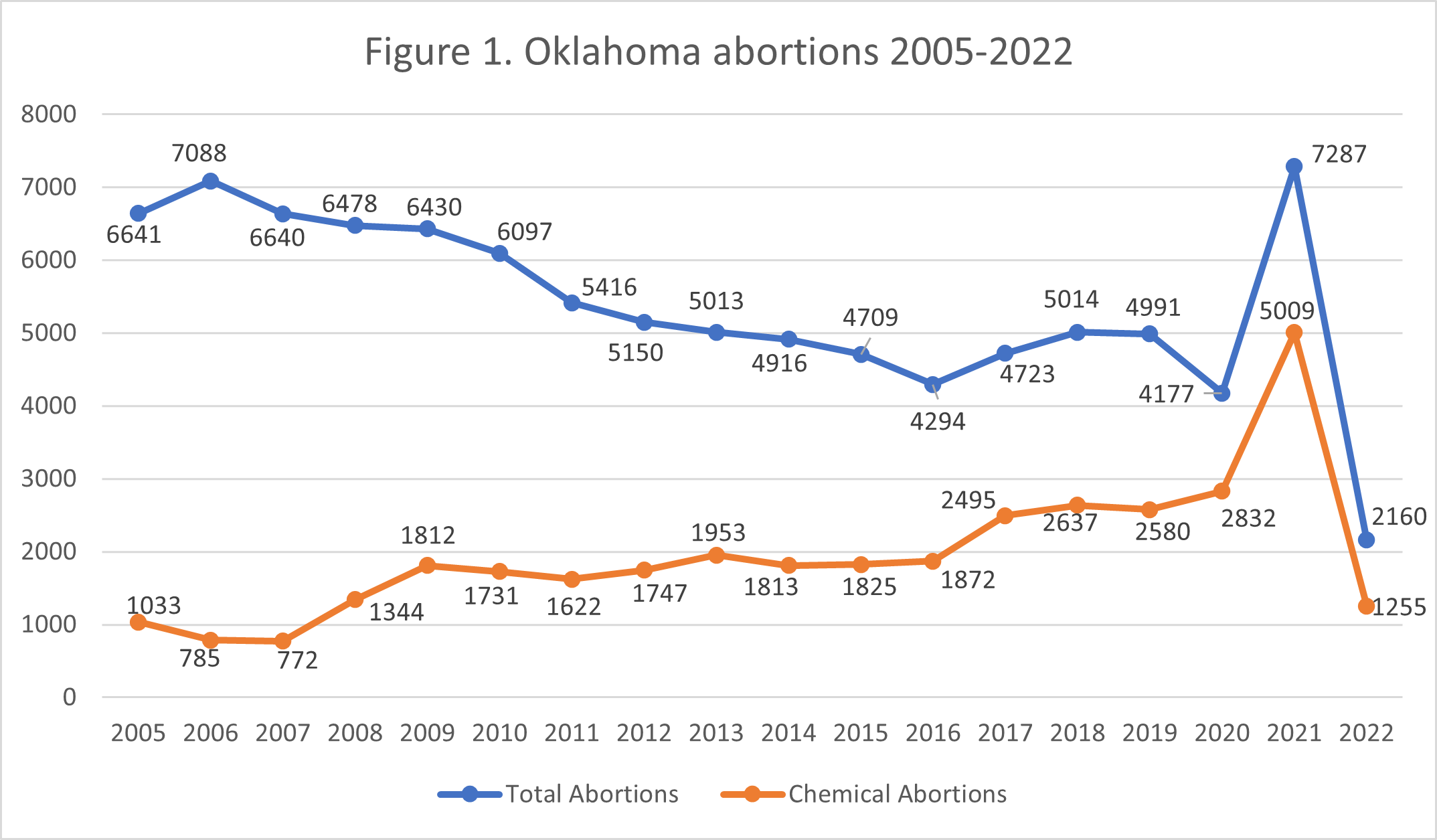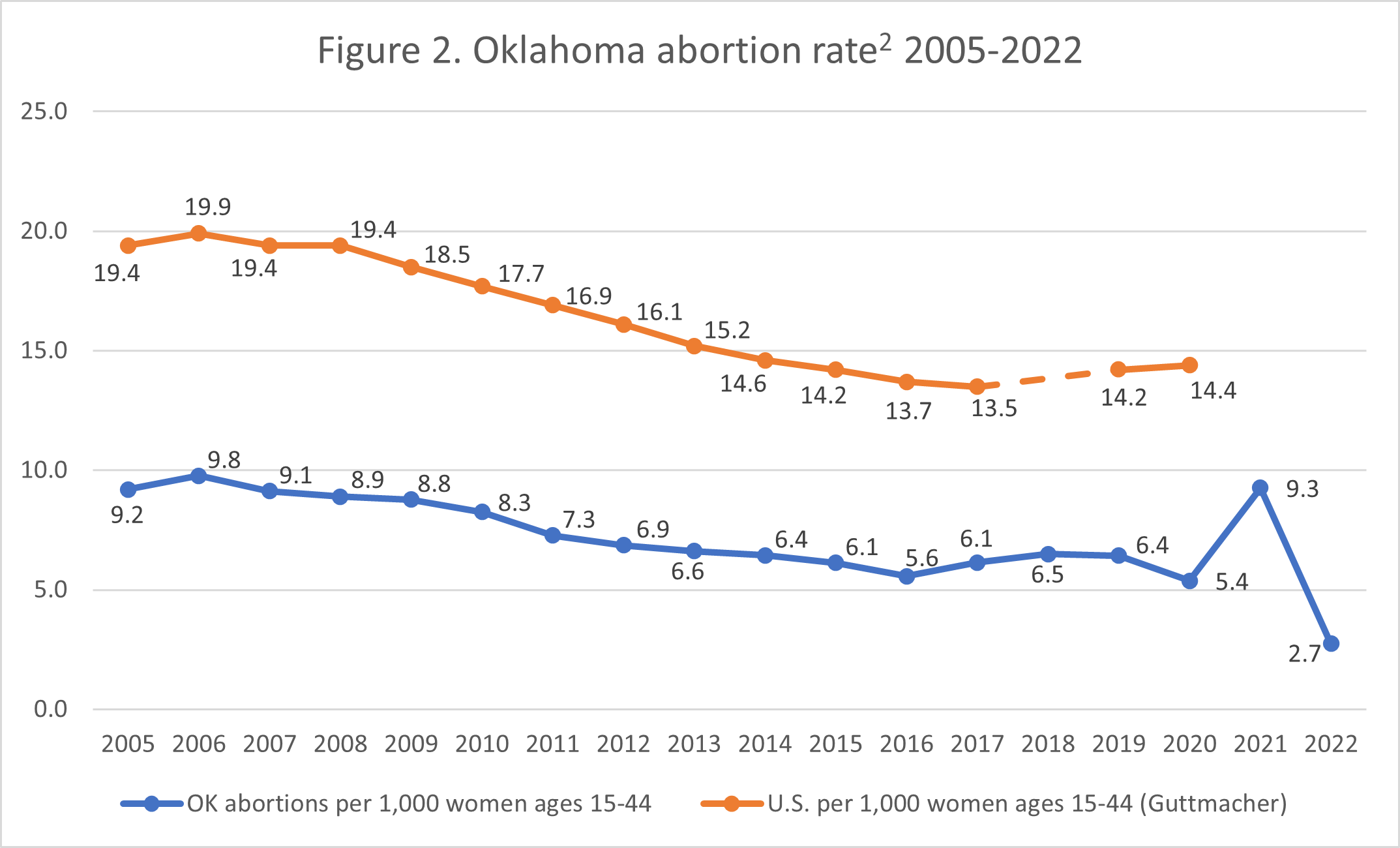Abortion Reporting: Oklahoma (2022)
The first state to publish its full 2022 abortion report online is Oklahoma. Its 2022 report was published on the website of the Oklahoma State Department of Health (OSDH) in May 2023. The report shows that abortions decreased significantly.
Statistics and Changes in Oklahoma Abortions, 2021-2022

The report does not include information on Planned Parenthood’s Oklahoma abortion market share.
Abortion Totals and Trends
There were 2,160 abortions reported in Oklahoma in 2022, down significantly (by 70 percent) from 7,287 in 2021 (Fig. 1). Chemical abortions dropped 75 percent from 5,009 in 2021 to 1,255 in 2022, making up 58 percent of total Oklahoma abortions. The Charlotte Lozier Institute (CLI) estimates that Oklahoma’s state abortion rate decreased 70 percent to 2.7 abortions per 1,000 women ages 15 to 44 and is at its lowest point since the state started using its current reporting format in 2002. It is important to note that abortion totals, chemical abortion totals and abortion rates for years 2019-2021 have been updated on the graphs below. The state’s induced termination of pregnancy (ITOP) dashboard has updated totals for these years and notes that a significant number of abortion reports were submitted after the state had released annual abortion reports for 2019, 2020 and 2021.
State Report Summary
Unlike previous years, in 2022, a majority (58 percent) of Oklahoma abortions were performed on women from other states, compared to 42 percent performed on Oklahoma residents. Of the out-of-state residents who had an abortion in Oklahoma, 1,119 were Texas residents (52 percent of the Oklahoma total), while women from Arkansas (92 abortions), Missouri (24), Kansas (13), and Louisiana (five) also obtained abortions in Oklahoma in 2022. The numbers of abortions performed on women from other states were suppressed.
A potential reason for the large percentage of out-of-state women obtaining abortions in Oklahoma is that during the period covered by the report (January-May 2022), Oklahoma had a more permissive gestational law than Texas, which likely contributed to the increase in Texas women seeking abortions in Oklahoma. By January 2022, SB8 in Texas, which prohibits abortion after a baby’s heartbeat is detected (typically around six weeks’ gestation), had been in effect for four months. Until May 3, 2022, abortion was legal in Oklahoma up until 22 weeks’ gestation, making the state a destination for out-of-state women seeking abortions.
Twelve percent of Oklahoma abortions were performed on girls under the age of 20. Thirty-four percent were obtained by women ages 20 to 24, and 27 percent were on women ages 25 to 29. Sixteen percent of the abortions were performed on women ages 30 to 34, and 11 percent were on women ages 35 and older.
Just under half (47 percent) the abortions reported in Oklahoma were performed on white women. Twenty-eight percent were obtained by black women, while five percent were performed on Asian or Pacific Islander women and four percent were on American Indian or Alaska Native women. Seventeen percent were performed on women of other races. The black abortion rate (8.8 abortions per 1,000 women ages 15 to 44), while down significantly from approximately 29.8 per 1,000 in 2021, was still five times higher than the white abortion rate of 1.8.
Seven percent of Oklahoma abortions were conducted on women who had not graduated from high school, while 45 percent were on women with a high school diploma or GED. A third of the abortions were obtained by women who had attended some college, and 14 percent were on women with a bachelor’s degree or more. Fifteen percent of the abortions were performed on married or separated women, and 85 percent were performed on women who were not married.
Thirty-two percent of the abortions reported in Oklahoma were performed on women who had never been pregnant before. Twenty-two percent were on women with one previous pregnancy, and 46 percent were on women with two or more prior pregnancies. According to the most recent data available in the online portal, 44 percent of Oklahoma abortions were obtained by women with no prior live births. Twenty-four percent of abortions performed in Oklahoma were on women with one prior live birth and 32 percent were on women with more than one live birth. The portal does not include updated data on prior abortions, but the report shows that 41 percent of the abortions were performed on women with no previous abortions, 20 percent were on women with one prior abortion, and seven percent were on women with more than one. The number of prior abortions was not reported for 32 percent.
Women obtaining abortions in Oklahoma are asked to report their reasons for choosing abortion; multiple reasons may be provided for a single abortion. As in previous years, most abortions were performed for elective reasons. There were 52 forms that indicated that the abortions met the definition of medical emergency in Section 1-738.1A of Oklahoma Statutes and 11 that qualified as medical emergencies under Section 1-745.2, both of which define a medical emergency as an immediate physical risk to the woman’s life or a major bodily function. There were 66 forms that indicated the abortion was necessary to save the mother’s life, although the report does not include whether the risk was immediate. Sixteen abortions were performed for rape and 12 for incest. Seven abortions were performed because the “mother wanted a child of a different sex.” A sizeable number of women attributed their abortions at least partially to the influence of other people in their lives: 424 abortions were performed because the husband or partner wanted the abortion, and 138 because the woman’s parents wanted the abortion.
Medical
A majority of Oklahoma abortions, 58 percent, were chemically induced. Eighteen percent were performed using suction aspiration, and eight percent were performed via dilation and curettage. Another eight percent were dilation and evacuation procedures. The type of procedure was not reported for eight percent of the abortions. For a large majority (89 percent) of the chemical abortions (1,113 abortions), the physician was in the room when the drug was first administered.
Just under half (48 percent) of the abortions performed in Oklahoma occurred at eight weeks of gestation or earlier. Twenty-six percent were reported between nine and 10 weeks of gestation, and 11 percent were performed between 11 and 12 weeks. Ten percent occurred between 13 and 15 weeks and four percent were performed between 16 and 20 weeks of gestation, while six abortions were performed at 21 weeks of gestation or later. The gestational age was not reported for 12 abortions. Until May 3, 2022, Oklahoma limited abortion at 20 weeks’ post-fertilization, approximately 22 weeks of gestation, and required that post-fertilization age be determined except in medical emergencies. Probable post-fertilization (PPF) age was determined for 64 percent and not determined for 12 percent. PPF age was “not applicable” for 23 percent of the abortions, although the report did not indicate why the requirement was not applicable, and for five abortions it was not reported whether PPF age had been measured.
Fifty-three percent of the abortions were performed by OB-GYNs, and 47 percent were performed by general practitioners. The physician’s specialty was not reported for less than one percent of the abortions. Oklahoma collects information on whether the doctor performing an abortion possessed hospital admitting privileges, but this information was suppressed in the report, indicating the number is under 5 abortions. For 12 percent of the abortions, the woman was provided with anesthesia, while no unborn babies were anesthetized.
An ultrasound was performed in advance of 98 percent of Oklahoma abortions (79 percent abdominal, 18 percent vaginal, and two percent both abdominal and vaginal). Under the law in effect when abortions were occurring in Oklahoma in 2022, once the pregnancy reached eight weeks’ gestation the woman must be offered the opportunity to hear her baby’s heartbeat. In 2022, 419 women (19 percent of the total) had the heartbeat made audible for them to hear.
Sixteen percent of the unborn babies killed by abortion were incinerated. Thirteen percent were frozen for 30 days; the report does not indicate what happened to the babies’ bodies after this time period. Four percent were discarded as medical waste, and 0.5 percent were disposed of at home. The method of disposal was not reported for 67 percent of the abortions. The number of abortions for which it was known whether the unborn baby was a boy or girl and the number of babies of each sex was not reported.
Twelve abortions were reported by the doctor who performed the abortion to result in complications.1 The number of complications reported by other physicians was suppressed. There were six incomplete abortions in which pieces of the unborn baby or other tissue were left in the woman’s uterus. The numbers of failed abortions in which the pregnancy was ongoing, and cases of uterine perforation, infection, and hemorrhaging were suppressed. No women were known to have died from abortions in 2022, and no babies were reported to have been born alive.
Legal and Financial
Oklahoma’s informed consent law ensures that a woman is provided with the medical facts about her abortion and the options and alternatives available to her, except in cases of medical emergencies. Over 99 percent of the women undergoing abortion were given the informed consent material, and 15 percent chose to have more information mailed to them. Under the law in effect when abortions were occurring in Oklahoma in 2022, when an abortion was performed after 20 weeks of gestation, additional informed consent material had to be provided; in 2022, there were fewer than five abortions that met this requirement, but all of these fell under the medical emergency exception to the informed consent requirement. but all of these fell under the medical emergency exception to the informed consent requirement.
In Oklahoma, public facilities or employees are prohibited from performing abortions unless an abortion is sought due to rape, incest, or a risk to the mother’s life. In 2022, the number of abortions performed within the scope of a public employee or agency was suppressed.
Parental notification and consent must be provided before an abortion is performed on a minor in Oklahoma. In 2022, there were 48 cases in which parental consent was obtained in advance of abortion. There were zero instances in which parental consent was not obtained due to a medical emergency, where a parent was notified subsequently, or where a judicial waiver was obtained.
Nearly all the abortions reported in Oklahoma (98 percent) were self-pay. Twelve abortions were covered by private insurance and 21 were funded using some other means. The number of Medicaid-funded abortions was suppressed. The method of payment was not reported for six abortions.
The majority of Oklahoma abortions cost more than $600, with nine percent performed for less than $500 and less than one percent for $501 to $600. Seventy-two percent of the abortions cost $600 to $800, and 16 percent cost over $800. Cost was not reported for two percent of Oklahoma abortions.
Abortion by Month in 2022
Legislation that went into effect in Oklahoma before Roe v. Wade was overturned has had an enormous impact on abortion trends in the state. On May 3, 2022, the state’s Texas-style heartbeat law, SB 1503, went into effect, which meant that abortions could not be performed after an unborn baby’s heartbeat was detected. Shortly after, another law, HB 4327, went into effect on May 25, 2022. This law protected unborn babies throughout pregnancy and limited all abortions except in cases of rape, incest, or a risk to the mother’s life. Following the passage of HB 4327, all of Oklahoma’s abortion centers ceased performing abortions. The evidence of the impact of these two laws is visible in the monthly abortion totals before and after the laws went into effect in May 2022.
Table 1-Number of Abortions by Month, 2022
| 2022 | |
| January | 615 |
| February | 593 |
| March | 800 |
| April | 147 |
| May | 5 |
| June | 0 |
| July | 0 |
| August | 0 |
| September | 0 |
| October | 0 |
| November | 0 |
| December | 0 |
Legislative Changes After Roe v. Wade was Overturned
Impactful legislation also went into effect after Roe v. Wade was overturned in June 2022 and contributed to the fact that no abortions were reported in the state from June 2022 to December 2022. When Roe v. Wade was overturned on June 24, 2022, Oklahoma’s pre-Roe law (pg. 239, Section 21-861) protecting unborn life throughout pregnancy and limiting abortion to cases where the life of the mother was endangered went into effect that same day. Another law limiting abortion throughout pregnancy (SB 612) was passed in April 2022 and went into effect on August 25, 2022, superseding both the pre-Roe law and HB 4327, which had been in effect since May 25, 2022. The bill limits abortion to cases where the life of the mother is endangered by her pregnancy. On May 31, 2023, the Oklahoma Supreme Court decided that SB 1503 and HB 4327 were unconstitutional because of the two laws’ medical exceptions language. The court ruled that the Oklahoma Constitution allows for abortions in cases where the mother’s life is endangered and that the laws were unconstitutional because they only allowed abortions after a woman experienced a medical emergency, not during the emergency. Despite this court ruling, life is still protected at conception in Oklahoma as the state’s pre-Roe law is still in effect.
State Ranking
In CLI’s 2016 paper evaluating abortion reporting across the 50 states, Oklahoma claimed first place. Although unborn babies are now protected in Oklahoma, abortion reporting remains important. Since some women may travel out of state for abortions or attempt to order abortion pills online, Oklahoma could remind physicians of the requirement to report any abortion-related complications that they encounter, regardless of where the abortion was performed or where the complications were treated, including emergency rooms. Oklahoma could also ensure that abortions performed under exceptions to its state abortion law are reported.


- Statistics on abortion complications reported here represent a minimal number of complications, as this data is collected in a non-systematic and non-verifiable way. As such, this data cannot be used to calculate either an accurate abortion mortality rate or an accurate abortion complication rate for the state.
- Rates were calculated by CLI using the following formula: (total number of abortions performed in Oklahoma ÷ number of resident women ages 15-44) x 1,000. Rates may differ slightly from previous CLI articles due to revised population estimates. Population estimates were obtained from CDC WONDER. Estimates for 2005-2009 are intercensal estimates of the July 1 resident population. Estimates for 2010-2019 are Vintage 2020 postcensal estimates of the July 1 resident population. Estimates for 2020-2022 are Vintage 2021 postcensal estimates of the July 1 resident population as 2022 population estimates have not been released. Estimates were produced by the U.S. Census Bureau and the National Center for Health Statistics.
Click here to view reporting from:2024202320212020201920182017




























